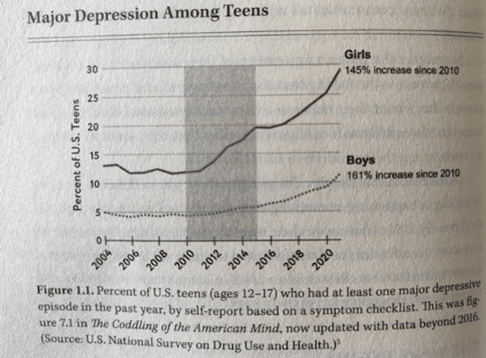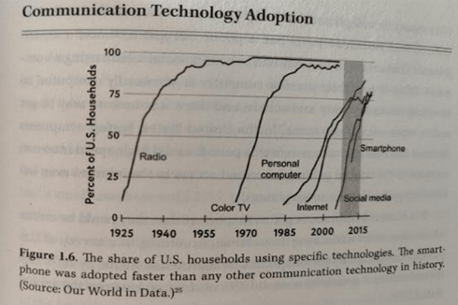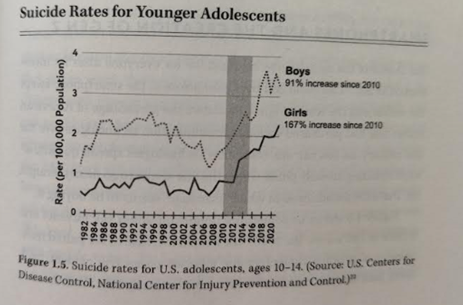Thoughts on the Anxious Generation by Haidt
15thFeb'25
I had long suspected the damaging impact of smartphones and social media on Gen-Z but after reading this book, I am floored by the extent of the problem. This is not your typical pop-psychologist book with thin data being used to make over the top claims. Let me just show you Haidt’s argument using three charts –
1) The steep rise of mental health issues from 2010 onwards


2) What was special about this period?


In 2007, the first smartphone was introduced in the USA. By 2016, 79% of teens owned a smartphone, as did 28% of children between the ages of 8 and 12. While technology was accessible even before this era, this was the first time it was at arm’s reach of almost everyone. Adolescents started spending more time in the virtual world, with almost one out of 4 teens saying they were online almost constantly with a sizeable amount of it spent just on social media. That number has obviously increased multifold now.
Haidt has presented mental illness data from other countries including Canada, UK, Australia and Nordic countries. The trend is consistent across all of them. The issue is not unique to America’s socioeconomic and political landscape, this is a very much global problem.
3) This is not just reporting bias


Another critique can be that teens are just more likely to diagnose themselves as anxious or depressed because of increased awareness about these issues. That’s a great point, but Haidt’s book has the research to back why that is not the case:
Are you convinced? Because that is enough to convince me about the extent of the issue. I would argue if we had extensive research on India’s mental health data, we would observe the same trends between 2016 and 2020. Around 2016 is when India finally got affordable internet access for the first time along with increased smartphone penetration.
I am worried about how this harmed our generation and what it is doing to the kids of today. I don’t have to give an example here. I am Exhibit A. I have lately grown extremely concerned about my phone usage. But translating this self-awareness into action has proven to be more challenging than I initially thought. I had written earlier about my experience.
Another excellent point Haidt brings up is that with time, parents have become more obsessed with the idea of safety and protection. They have been too protective in the real world while not recognizing that they have no control over their child’s virtual world. Kids up to 18 need to be provided with an environment where they are free to grow, where they are exposed to minor risks frequently. They need to be granted doses of responsibility, that’s how we can best prepare our kids for a future where they learn to be social and how to regulate their emotions. Please let them get out of the house and explore the world.
I agree with Haidt that the minimum age to sign up for social media platforms should be increased from 13 to 16. As a kid, I had no need to be on Facebook when I was 10. Why are there no age verification checks deployed by these social media firms even today?
I am also surprised by the disproportionate impact social media has had on young girls. I suspected that to be the case, but on paper the gap is too wide. I also believe in general young men have been struggling with lack of purpose and meaning in life for a few decades, feelings which are perhaps more difficult to capture on a graph. I will think about this later.